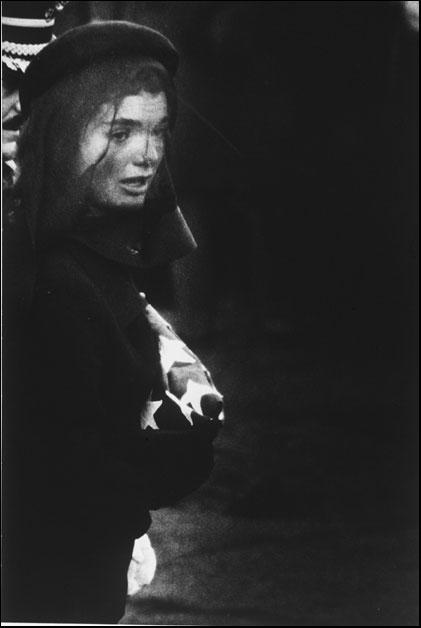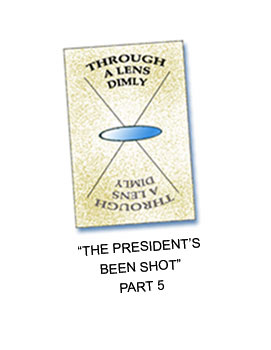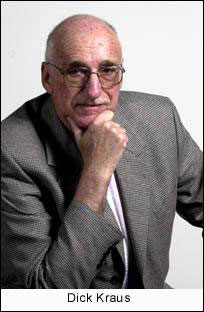"THE
PRESIDENT'S BEEN SHOT"
PART V
ARLINGTON
NATIONAL CEMETERY
by
Dick Kraus
Newsday
Staff Photographer (retired)
Bob Luckey and I parted at the airport cab stand in Washington. I
went to the Pentagon and got my credentials and boarded a waiting bus
taking the press to Arlington National Cemetery. It was another crisp
November Day.
Once
we arrived we were herded in a group to a roped off area
on a rise overlooking the site where Kennedy would be laid
to rest. I
scrambled to the front of the area which was important because
I wasn't
blessed with 500mm or even a 300mm lens like many of those
around me
carried. In fact, the longest lens I owned in those days was
a 135mm. The
press site was probably 50 yards from the open grave. At the
office, the
night before, I had discussed these obvious handicaps with
my Director of
Photography. We didn't have a camera plan in effect back then
and we
photographers had to spend our own money to buy equipment.
And we were
sorely lacking in long lenses.
My boss offered me the use of his own 180mm lens. That helped,
but
it meant that I had to borrow his M-3 Leica and Visoflex housing,
since I
owned Nikons. The Visoflex was a cumbersome device that attached
to the
front of the Leica body and contained a mirror and prism arrangement
that
converted this magnificent range finder camera into an awkward
single lens
reflex. This particular model had a manual mirror. You had
to push a lever
to bring the mirror into place for focusing. When you fired
the shutter,
the spring loaded mirror would clank out of the way of the
film plane. But
you then had to manually push the lever to cock the mirror
for the next
shot. And, to make matters worse, the damned Leica lenses focused
counter-clockwise to infinity, the opposite of the Nikon. Now
didn't that
make a handy situation? Every time I dropped one camera and
picked up the
other I found myself going out of focus instead of getting
sharper.
We
had to stand in place for a couple of hours and there was no
respite from the cold. No going for coffee. No going to the
rest room. If
you left your place, it was gone.
The grave site was on a rise and you could look across the cemetery
to the Potomac River and eventually we could see the funeral
procession
approaching the bridge over the river. In the quiet air you
could hear the
muffled drums beating the funeral cadence. A large crowd
had gathered along
the roads and paths in the cemetery, which was open to the
public even on
this day.

Jackie
Kennedy, flanked by the President's brothers, Bobbie
and Ted, walk to the grave.
© 1963 Newsday Photo by Dick Kraus
|
|
The
crowds fell silent as the procession made its way to the
grave site. Still cameras started to click as the casket
was unloaded and placed on a stand next to the raw grave.
The mourners and dignitaries assembled with the widow and
her children in the center. The two surviving Kennedy
brothers and their families joined Jackie and her children
at the
front of the mourners. No one dared dream that Bobbie
Kennedy would soon be laid to rest near his brother; the
victim of yet another assassin's bullet.
|
I
could see Prince Phillip of England, President Charles
DeGaulle of France, Emperor Haille Sellaise of Ethiopia
as well as senators and congressmen from our government. |

| ©
1963 Newsday Photo by Dick Kraus |
|
Words
of prayer drifted across the landscape in the cold. clear
air. Bob and Ted Kennedy spoke of their brother's dreams
and tv cameras and
radio recorded what they said. Hundreds, if not thousands
of feet of 35mm
film captured the history of it all by the assembled still
photographers
from almost every country in the world.
A
flight of Air Force jet fighters
flew low over the grave in the "missing man" formation.
I noticed a strange
thing. The ground was covered with dead leaves; the vestiges of
Autumn. And suddenly the leaves were floating skyward and there was no
wind. Maybe it was the vacuum caused by the low flying jets. Or maybe
I was
looking for some divine sign that there was some higher power looking
after
us in spite of the chaos and insanity of the past few days. Strange
thoughts. I'm not a religious person, but, maybe that day I was.
The US Navy Band played Kennedy's favorite hymn, "Nearer My
God To Thee." And I could see the thousands of steel hard news
people surrounding me,
wipe their eyes. Suddenly my view through my camera's finder was
cloudy and I felt warm tears running down my cold cheeks. It was
impossible not to get caught up in
the emotions of the moment.

| ©
1963 Newsday Photo by Dick Kraus |
|
The
Honor Guard raised their rifles and volley after volley
echoed across the high ground and down into the low places
of the cemetery and surrounding area. Nearby a solitary
bugler sounded the mournful notes of Taps. And far off,
another bugler played a tremulous echo. Now people all
across the cemetery were weeping, openly. The flag of the
United States was removed from the casket and solemnly
folded. An Army officer stepped forward and took it and
placed it in Jackie Kennedy's hands saying, "From
a grateful nation."
The picture that I took at that moment, through a backwards focusing
borrowed 180mm lens, is one that I look upon and cherish even now. The
scene was gray and bleak and made even more so by the dark clothes of the
mourners.
My photo shows Jacqueline Kennedy, widow of the President, holding the
flag in her arms, and even through the black veil she wore, you could see
the bewilderment in her eyes and she stood alone, surrounded by thousands.
|
-30-
EPILOGUE
As a brief footnote, let me conclude with the following
observations.
The
ceremony ended and a very subdued bunch of journalists
hobbled back to the bus. I say hobbled, because most of
us were almost
crippled from standing so long in the biting cold and on a slope
so steep that our
ankles were stretched abnormally for that length of time.
Luckey and I flew back to NY later that evening for another
session
of souping film, making selections and doing captions.
The next day, the
paper belonged to Bob and I. If I remember, there wasn't
a single wire
photo used. There were pages and pages devoted to the
story and they used
our pictures exclusively because we had made sure that in addition
to our
assigned coverage, we also included sidebars and interesting
close-ups and
wide shots. It was a pretty heady experience for a couple of
youngsters.
When I came to work, the next day, the boss gave me an assignment
to cover a ribbon cutting for a department store in a nearby
town. Years
later he told me that he gave me that assignment specifically
to bring me
back to reality. He said, "You won't cover many presidential
funerals
during the span of your career as a news photographer. But,
you'll damn
sure cover a lot of ribbon cuttings."
He
was right.
Dick Kraus
newspix@optonline.net
http://www.newsday.com
|




